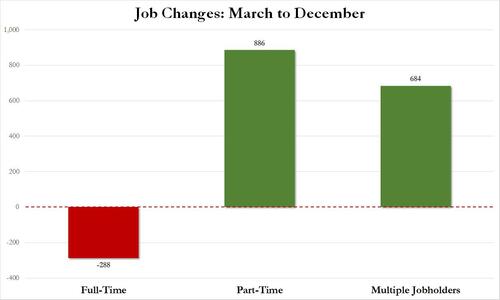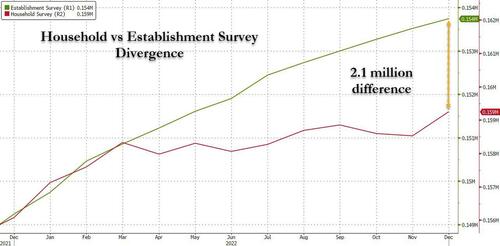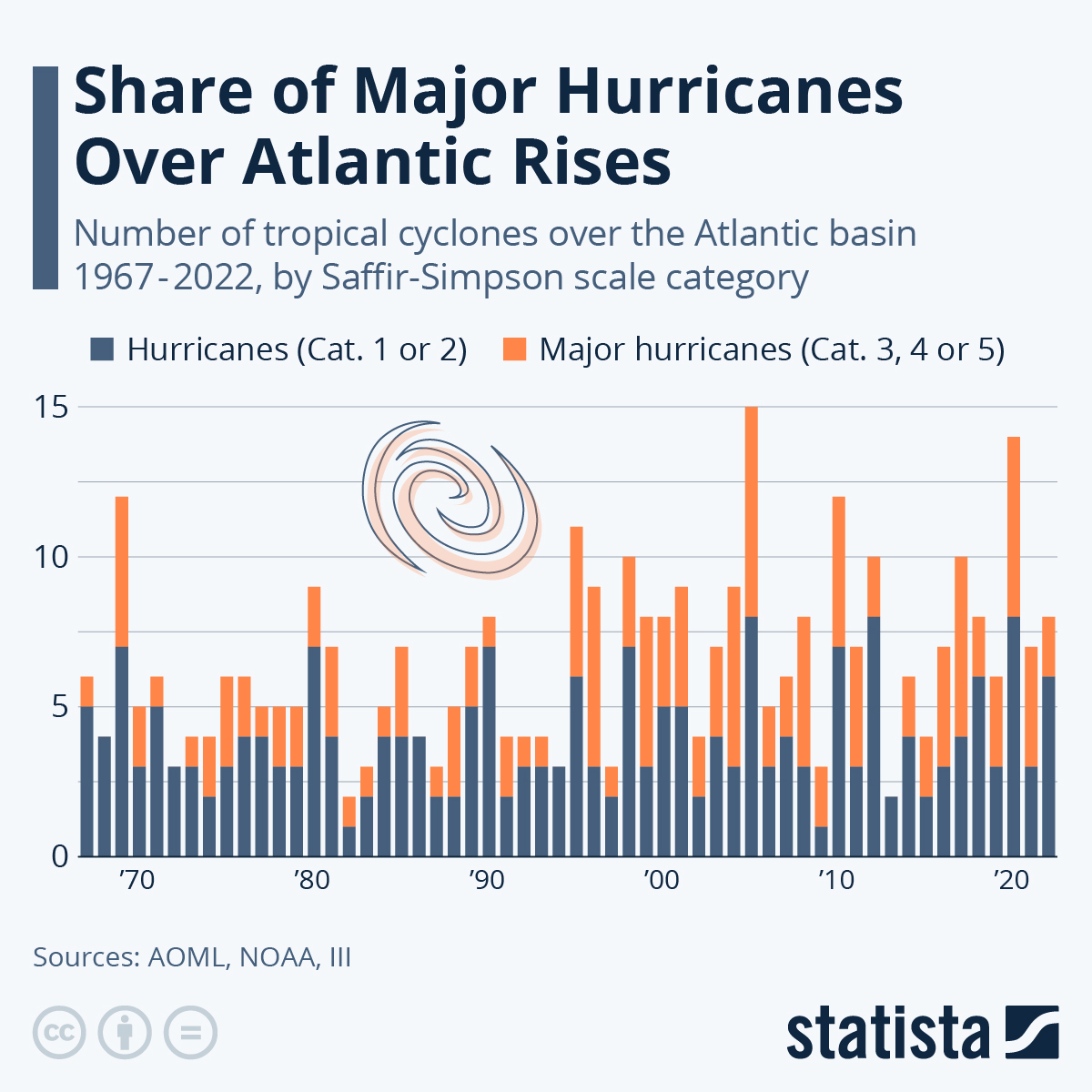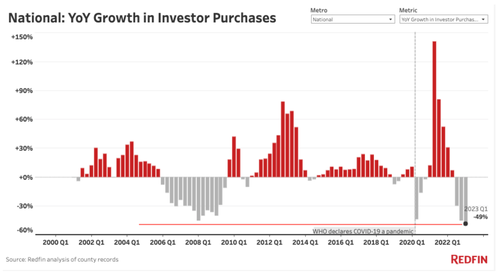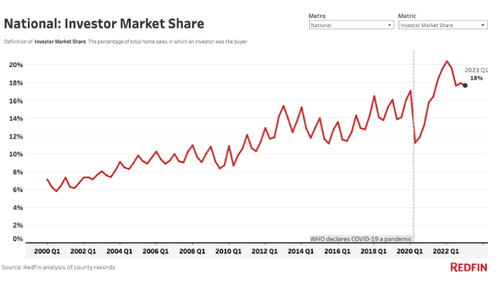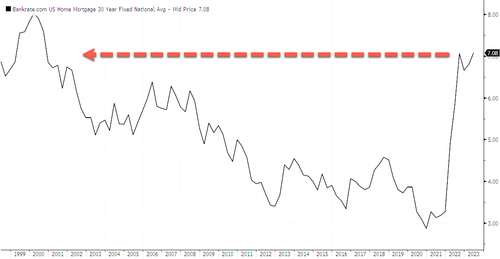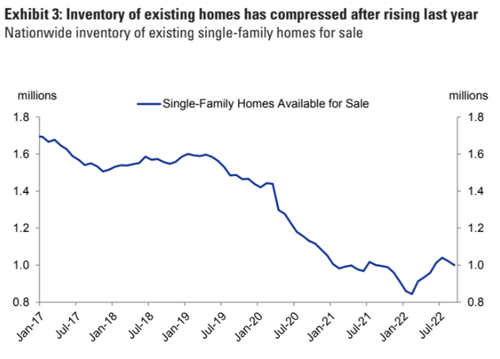All New US Jobs Since The Covid Crash Have Gone To Foreign-Born Workers
We live in a strange time, one where the formerly unthinkable – skepticism among the “very serious people” about government data veracity – has become mundane. And yet even though numerous bank analysts and strategists, and this site of course, have repeatedly raised questions and concerns about the credibility of the most important US economic data – the monthly jobs report – nothing ever changes and if it does, it comes in the form of periodic “seasonal adjustment” resets where we “learn” that all the data that guided markets and central banks, had been fake, manipulated wrong for years.
But even if one ignores the blatant manipulation of economic data by self-serving administrations, who hope to generate political brownie points by casting the economy in a far stronger light than is merited in reality, there are still various bizarre offshoots within the data which few notice yet which are instrumental to maintaining the fake narrative.
Such as this: readers are probably aware that according to the BLS, there are now roughly 3.3 million more jobs (155.7 million) than there were at the peak just before the covid crash (152.4 million).
On the surface, this is an impressive accomplishment, as a deficit of some 22 million jobs has been erased in under three years.
But then, if one starts digging, some peculiarities emerge, like for example that much of jobs created in recent years have gone to “multiple jobholders“, meaning that not every “payroll” has been assigned to a unique individual, but instead there are now people who hold two, three or more jobs to make ends meet.
Or that much of the recent job creation has gone to low-paying part-time workers while full time jobs have stagnated.
Or that according to the household survey there was virtually no new jobs created for much of 2022 even as the establishment survey indicated that over 2 million new jobs had been added over the same period.
To be sure, it didn’t take long after we pointed out these glaring narrative “glitches” and discrepancies for the BLS to notice and to make the appropriate adjustments and historical revisions to the data to make it coherent. After all, bureaucrats are not very diligent and attention oriented, and manipulating bureaucrats are even worse.
Yet one place where the BLS has allowed a glaring data deficiency to persist, is in what will soon be a very politically charged and sensitive data series: where have all the new workers come from.
As noted above, if one believes the BLS, US payrolls are now a record high 155.7 million, or 161 million employed workers according to the Household survey. But if one digs a little deeper, one finds something rather peculiar: all of the jobs created since the covid crash have gone to foreign-born workers!
That’s right: as shown in the chart below, there are currently 131.1 million native-born US workers, which is down more than half a million from the pre-covid peak of 131.7 million reached in October 2019 (data source: Federal Reserve). Meanwhile, if only looks at the number of foreign-born workers, here the data paints a very different picture: having peaked at 27.8 million in Feb 2019, the number of foreign-born workers has not only recovered its covid crash losses, but has increased by an additional 2.2 million to a record 30.0 million as of April 2023!

This means that all the new job creation since the covid crash has gone to foreign workers, with native-born workers stagnating and still unable to break above pre-covid highs, even though if one merely extends the pre-covid trendline, native-born workers should have long ago surpassed their 2019 highs. Said otherwise, millions of native jobs have quietly gone to (lower paid) foreigners.
But what if the data shown above is merely a product of uneven distribution of hiring while the labor force growth has been similar. Good question, and to answer that we have looked not at the change in absolute jobs/workers but the change in labor forces, native-born and foreign-born, indexed at 100 as of Oct 2019. The result, shown below, speaks for itself.

And there you have it: both the number of native-born workers and the actual native-born labor force have stagnated, while foreign-born workers have flourished and captured market share or rather employment and wage share from native Americans.
To be sure, there is much to analyze: unfortunately the BLS does not break down the “foreign-born” data set into legally and illegally-immigrated foreign-born workers, although considering that it was virtually impossible for legal foreigners to enter the US – let along work in it – for nearly two years after the covid pandemic broke out, it is rather safe to assume that much of the foreign-born work has gone to illegal immigrants.
Which then begs the question: how does this impact inflation? We already know that wage inflation is supposedly off the charts, but if the bulk of new hiring has gone to foreign-born workers who, for the most part, represent a cheaper labor option for employers, does that mean that wage inflation would be that much higher if most new workers had been native-born? What will happen to inflation if, say, Trump or DeSantis makes it a campaign pledge to focus on hiring native-born workers?
And another question: what does this track record mean for the coming presidential mudslinging campaigns – what impact will it have on the reputation of, say, Joe Biden, when he is asked why all new jobs under his administration have gone to foreign-born workers while native-born Americans have been left to stagnate?
We hope to have the answers soon enough; for now, however, we have another jobs report to focus on in just a few hours. And if the recent track record of the BLS “accuracy and integrity” is any indication of what to expect, tomorrow’s numbers should push what are already ridiculous job numbers well into the realm of peak absurdity.
Tyler Durden
Thu, 06/01/2023 – 21:16
via ZeroHedge News https://ift.tt/Ot4S5jL Tyler Durden

